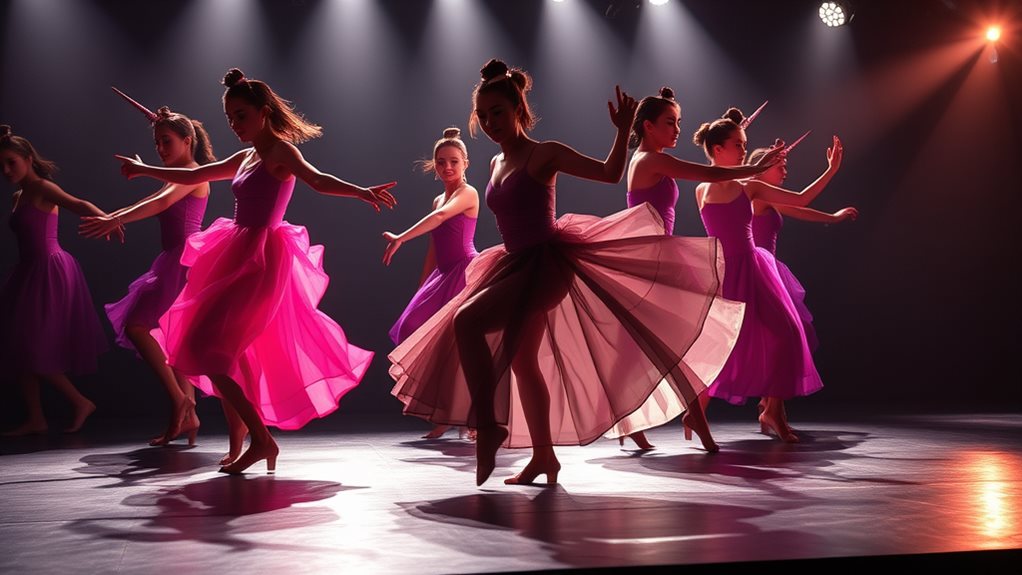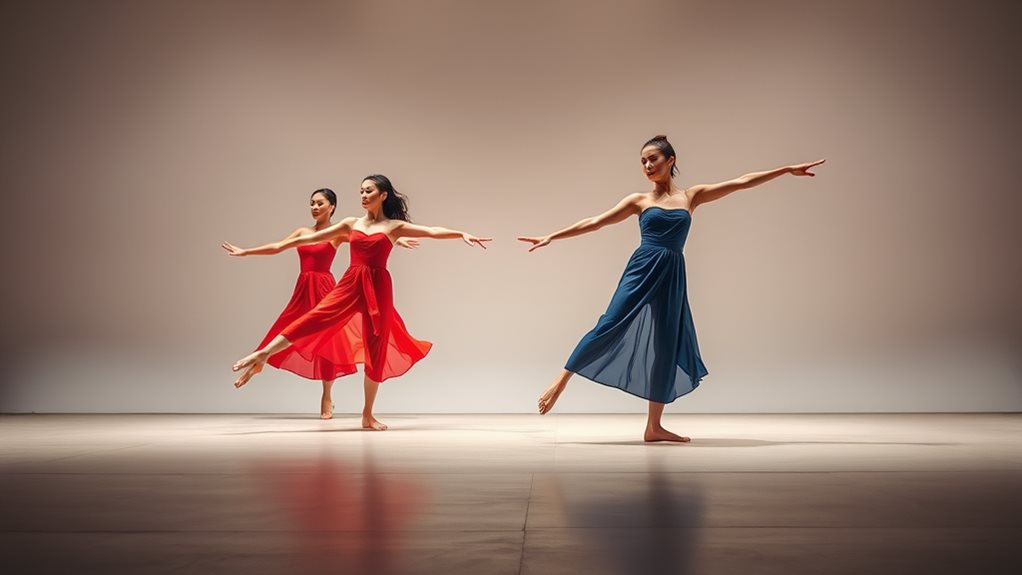You explore how contemporary dancers integrate traditional Pangalay techniques with modern elements. By mastering intricate hand movements, youth are learning and preserving the cultural heritage. These practitioners blend traditional instruments with contemporary music, enhancing emotional resonance while staying true to roots. Digital archiving plays a crucial role, capturing performances and sharing them globally. Workshops and mentorship programs ensure generational continuity. Through events abroad, cultural exchange is facilitated, maintaining Pangalay's relevance. By incorporating digital visuals, modern interpretations honor traditional roots yet innovate, hinting at a deeper understanding of the dance's evolution.
Origins and Significance

Originating in the 14th century within the royal courts of the Sulu Archipelago, the Pangalay dance is deeply rooted in the nobility and cultural exchanges of its time, performed primarily by the Tausug and Samal tribes.
This traditional dance reflects the complex maritime heritage of the Sulu region, with intricate hand movements that mimic ocean waves, symbolizing fluidity and grace intrinsic to Tausug culture.
Fingernail decoration in Pangalay carries significant cultural meaning, with long, ornate nails not only enhancing aesthetic appeal but also serving as a percussive element during performances.
The cultural significance of Pangalay extends beyond its aesthetic function, as it's deeply intertwined with Tausug cultural identity. It's often performed during celebrations and important events, reinforcing community pride and preserving cultural heritage.
The historical significance of Pangalay has spurred modern preservation efforts, aiming to ensure that this traditional dance adapts to contemporary interpretations while remaining true to its origins.
Traditional Costumes
Reflecting the rich cultural heritage of the Tausug people, traditional costumes in the Pangalay dance weave intricate stories of their connection to the land. These costumes, crafted from silks, cottons, and natural fibers, embody a deep reverence for tradition through their meticulous design. Intricate patterns, beads, and sequins, each with symbolic meanings in Tausug society, enhance the visual vocabulary of the dance. Attention to detail is paramount, as artisans skillfully craft elaborate headdresses, ensuring every element speaks volumes about cultural narratives.
| Element | Symbolism | Craftsmanship |
|---|---|---|
| Silks, cottons | Unity, organic connection to earth | Hand-woven fabrics |
| Beads, sequins | Status, wealth, community bonds | Time-intensive sewing |
| Headdresses | Leadership, spiritual connection | Precise embroidery |
These traditional costumes not only preserve cultural heritage but also create a mesmerizing visual impact, highlighting the beauty and fluidity of the Pangalay dance.
Hand Movement Techniques

A dancer must emphasize intricate hand movements, which demand years of practice to master, highlighting the critical role of finger independence and dexterity in crafting mesmerizing gestures. Each subtle flick of the wrist and delicate arm wave contributes to the fluidity and grace evocative of the region's maritime heritage.
These gestures, a blend of traditional and contemporary cultural practice, require precise timing and control. Dance performances rely on these movements to narrate stories and engage audiences deeply without words.
Here are key elements to focus on:
- Finger Independence: Practice isolating individual finger movements to create complex patterns that resemble the dance of ocean waves.
- Wrist Flicks: Perfect the art of subtle wrist flicks to add a dynamic flair that enhances the overall performance's fluidity.
- Arm Waves: Use precise arm waves to complement finger movements, ensuring that all gestures contribute to the seamless storytelling.
- Rhythm Integration: Sync hand movements with the rhythms of the accompanying music to strengthen the link between traditional cultural practices and modern interpretations, preserving the essence of the Tausug people's artistic expression.
Musical Elements
Strong rhythmic emphasis, notably driven by traditional instruments like the kulibit and kulintang, characterizes the music in Pangalay. These instruments, rooted in cultural heritage, provide a foundational layer that enhances the dance's emotional resonance. Rhythmic patterns and melodic phrases serve as narrative devices, intertwining with the dancers' expressions to elevate the storytelling aspect. However, contemporary dancers are not bound by tradition alone. They blend traditional sounds with modern adaptations, incorporating elements from jazz and rock to attract new audiences while preserving essential musical components.
| Traditional Instruments | Role in Pangalay |
|---|---|
| Kulibit | Accents rhythmic sections |
| Kulintang | Provides melodic variety |
| Gabbang | Supports complex rhythms |
| Balloan | Adds high-pitched fills |
| Agong | Marks significant moments |
This integration of modern and traditional musical elements fosters an immersive experience, allowing audiences to connect deeply with the cultural heritage and emotional depth of the dance.
Innovations in Choreography

Incorporating fusion styles, contemporary choreographers are reinterpreting Pangalay, blending traditional movements with modern and urban dance elements to create innovative performances that speak directly to younger audiences' tastes.
These adaptations involve several critical strategies:
- Projection screens during performances integrate vibrant visuals to enhance storytelling and provide a modern context for the traditional dance.
- Emphasis on emotional and meditative aspects of Pangalay allows dancers to express personal narratives through the rich vocabulary of movements rooted in tradition.
- Workshops led by experienced instructors focus on the precision and control required for intricate hand movements of Pangalay, ensuring authenticity while exploring new interpretations.
- Digital platforms showcase contemporary adaptations, fostering a global community of dancers engaged with the traditional art form, encouraging further creativity and exploration.
Through these innovations in choreography, contemporary dancers balance the preservation of Pangalay's essence with the evolution of art to remain relevant to modern tastes.
Digital Preservation Efforts
Among the strategies employed for safeguarding Pangalay, digital preservation efforts stand out by archiving performances, costumes, and historical records, ensuring the dance's cultural significance endures for future generations.
These digital archiving efforts leverage online platforms and social media to showcase Pangalay globally, fostering a sense of community and connection.
Collaborations with local communities capture authentic representations, enriching the understanding of cultural heritage.
Educational programs use digital media to teach younger generations about Pangalay's techniques and historical context, making them accessible and engaging.
Funding from cultural organizations has bolstered these efforts, allowing broader outreach to diverse audiences interested in traditional arts.
While these initiatives highlight the potential of technology in preserving Pangalay, the critical analysis must also consider the challenges of maintaining authenticity and sustainability in digital forms.
Cultural Legacy

The cultural legacy of Pangalay is a profound reflection of the Tausug people's artistic heritage, woven deeply into the fabric of their identity and community pride across the Sulu Archipelago.
As you explore the traditional aspects of Pangalay, it becomes clear that the dance embodies a rich history of Islamic expression and cultural significance.
Here are four key reasons why Pangalay remains a crucial element of this cultural heritage:
- Symbol of Identity: Pangalay fosters a sense of Islamic identity and community pride, making it an integral part of Tausug cultural practices.
- Craftsmanship Representation: Traditional costumes and intricate hand movements in Pangalay showcase the Tausug people's craftsmanship and cultural significance, emphasizing their artistic traditions.
- Generational Continuity: Efforts to preserve Pangalay involve community outreach programs that document and teach the dance to younger generations, ensuring its continuation as a vital cultural heritage.
- Balancing Tradition and Modernity: Modern interpretations honor Pangalay's traditional roots while integrating contemporary elements, maintaining its status as an important cultural legacy within the Filipino identity.
Your critical engagement with these aspects underscores the dance's enduring relevance and artistic value.
Future Performances
A new era of Pangalay emerges as dancers blend traditional artistry with modern technology, enhancing storytelling and attracting diverse audiences. By integrating elements like projection screens and digital visuals, you not only modernize the Pangalay dance but also deepen its narrative, making it more accessible and engaging to a younger generation.
To preserve Pangalay, workshops and mentorship programs are crucial, passed down by experienced practitioners to ensure techniques and narratives survive. Experimenting with fusion styles, you merge Pangalay with modern and urban dance forms, adding layers of innovation while honoring core movements. Such fusion not only diversifies the form but also sparks interest in its cultural roots.
Events and festivals showcasing Pangalay abroad facilitate cultural exchange, broadening its reach and recognition globally. Research and documentation efforts are vital to archiving performances and historical records, reinforcing Pangalay as a significant piece of cultural heritage.
These strategies collectively shape the future of Pangalay, ensuring its enduring relevance and artistic value.
Questions and Answers
What Is the Importance of Pangalay Dance?
Understanding Pangalay dance highlights its cultural significance, serving as artistic expression and reinforcing community identity through intricate movements and shared heritage.
What Best Describes Pangalay Folk Dance?
What best describes pangalay folk dance? It features elegant movements,承载 cultural symbolism, exhibits regional variations, balancing tradition with evolving interpretations.
What Is the Importance of This Folk Dance in Preserving the Philippine Culture and Tradition?
The importance of this folk dance in preserving Philippine culture and tradition lies in its reinforcement of cultural identity through unique artistic expression, all while fostering community engagement in historical and modern contexts.
How Does the Philippine Folk Dances Reflect the Communities Culture and Tradition?
How do Philippine folk dances reflect the community identity, cultural heritage, and social values? They showcase unique traditions, beliefs, emphasizing artistic expression and cultural significance, reinforcing community bonds and pride through intricate movements and costumes.